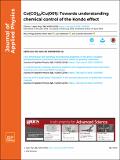Files in this item
Co(CO)n/Cu(001) : towards understanding chemical control of the Kondo effect
Item metadata
| dc.contributor.author | Bahlke, Marc Philipp | |
| dc.contributor.author | Wahl, Peter | |
| dc.contributor.author | Diekhöner, Lars | |
| dc.contributor.author | Herrmann, Carmen | |
| dc.date.accessioned | 2020-04-03T23:32:25Z | |
| dc.date.available | 2020-04-03T23:32:25Z | |
| dc.date.issued | 2019-04-04 | |
| dc.identifier.citation | Bahlke , M P , Wahl , P , Diekhöner , L & Herrmann , C 2019 , ' Co(CO) n /Cu(001) : towards understanding chemical control of the Kondo effect ' , Journal of Applied Physics , vol. 125 , no. 14 , 142910 . https://doi.org/10.1063/1.5079518 | en |
| dc.identifier.issn | 0021-8979 | |
| dc.identifier.other | PURE: 258791123 | |
| dc.identifier.other | PURE UUID: d7bbe565-2d1c-48d0-ac4e-f3c3a2e7f56d | |
| dc.identifier.other | RIS: urn:255053A67E4B0903352A6D9FAD66734A | |
| dc.identifier.other | Scopus: 85063965359 | |
| dc.identifier.other | ORCID: /0000-0002-8635-1519/work/57088505 | |
| dc.identifier.other | WOS: 000464451700011 | |
| dc.identifier.uri | https://hdl.handle.net/10023/19755 | |
| dc.description | The authors acknowledge the high-performance-computing team of the Regional High-Performance Computing Center at the University of Hamburg and the North-German Supercomputing Alliance (HLRN) for technical support and computational resources, and the DFG for financial support via SFB 668. | en |
| dc.description.abstract | The Kondo effect is a many-body phenomenon, allowing insight into the electronic and atomistic structure of magnetic adsorbates on metal surfaces. Its chemical control is intriguing because it deepens such insight, but the underlying mechanisms are only partly understood. We study the effect of increasing the number of CO ligands attached to a cobalt adatom on copper(001), which correlates with an increase in the Kondo temperature TK experimentally [Wahl et al., Phys. Rev. Lett. 95 , 166601 (2005)], by solving an Anderson impurity model parametrized by the density functional theory. Our results suggest that the orbital responsible for the Kondo effect is dx2−y2 for the tetracarbonyl and its combination with dz2 for the dicarbonyl. The molecular structures depend considerably on the approximate exchange–correlation functional, which may be related to the known difficulty of describing CO binding to metal surfaces. These structural variations strongly affect the Kondo properties, which is not only a concern for predictive studies but also of interest for detecting mechanical deformations and for understanding the effect of tip–adsorbate interactions in the scanning tunneling microscope. Still, by constraining the tetracarbonyl to C4v symmetry, as suggested by experimental data, we find structures compatible with the experimental trend for TK (employing BLYP-D3+U). This is not possible for the tricarbonyl despite the range of computational parameters scanned. For the tetra- and dicarbonyl, the increased TK correlates with a larger hybridization function at the Fermi level, which we trace back to an increased interaction of the Co 3d orbitals with the ligands. | |
| dc.format.extent | 12 | |
| dc.language.iso | eng | |
| dc.relation.ispartof | Journal of Applied Physics | en |
| dc.rights | Copyright © 2019 Author(s). This work is made available online in accordance with the publisher’s policies. This is the final published version of the work, which was originally published at: https://doi.org/10.1063/1.5079518 | en |
| dc.subject | QC Physics | en |
| dc.subject | NDAS | en |
| dc.subject.lcc | QC | en |
| dc.title | Co(CO)n/Cu(001) : towards understanding chemical control of the Kondo effect | en |
| dc.type | Journal article | en |
| dc.description.version | Publisher PDF | en |
| dc.contributor.institution | University of St Andrews. Centre for Designer Quantum Materials | en |
| dc.contributor.institution | University of St Andrews. School of Physics and Astronomy | en |
| dc.contributor.institution | University of St Andrews. Condensed Matter Physics | en |
| dc.identifier.doi | https://doi.org/10.1063/1.5079518 | |
| dc.description.status | Peer reviewed | en |
| dc.date.embargoedUntil | 2020-04-04 |
This item appears in the following Collection(s)
Items in the St Andrews Research Repository are protected by copyright, with all rights reserved, unless otherwise indicated.

